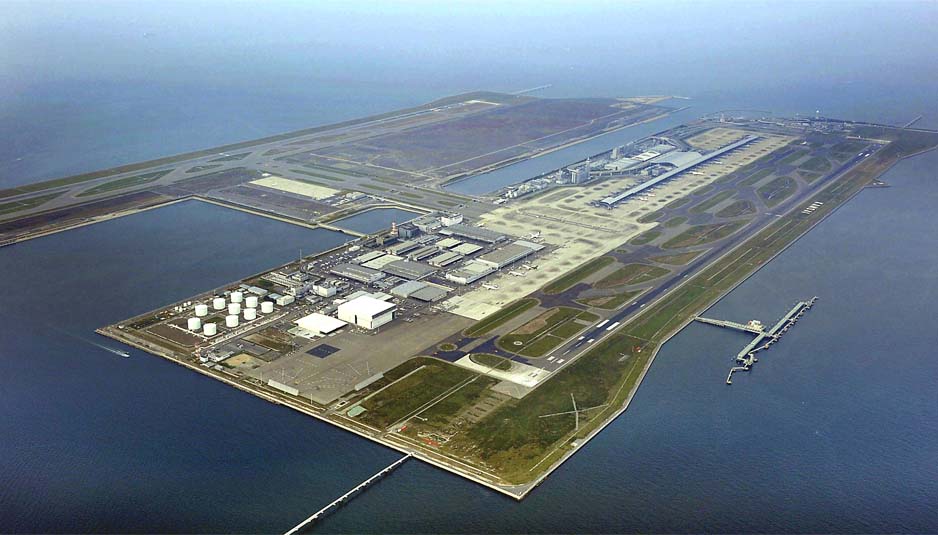Kansai International Airport: Smart Island Project

jto.s3.amazonaws.com
Maybe not everybody knows that in Japan, on an artificial island just 5 km from the mainland, lies one of the most ambitious infrastructure ever: the Kansai International Airport. Figure among the ten facilities that the American Society of Civil Engineers said “Civil Engineering Monument of the Millennium“.
The airport project, which primarily serves the cities of Osaka, Kobe and Kyoto (welcomes 100,000 passengers per day), was awarded to the Renzo Piano Building Workshop in 1988.
Is placed on a site previously, does not exist yet: an artificial island built specifically in Osaka Bay, 40 km south-west of the city. The island, of 4.37 km by 1.25, was built in five years.
The airport operates 24 hours a day and is one of the main transit routes for traffic to Japan, Southeast Asia and Australia. A bridge with two levels of 3.75 km connects the island to the mainland. At the top level there is a road, in the lower two railways independent.
THE ISLAND
The platform is a great work of Civil Engineering.
Rests on more than a million of support poles, crossing 20 meters of sea and 20 meters of muddy layer and then plant himself in 40 meters of rock. One of the main problems to which no attention was made at the design stage was that the muddy layer settles, and the arrangement is not regular. Fortunately it was possible to use different technologies to limit and control the lowering of the island: a set of sensors detect when the settlement at one point exceeded the planned maximum tolerance (10 mm).
Each pole is equipped with a calibration system, which works thanks to powerful hydraulic jacks: at the time when the post marks the deviation is adjusted and then locked in the new position. In the first phase, the phenomenon has had a considerable size, the island has settled to 50 cm between 1992 and 1996.
BUILDING AND COVERAGE
The building, 1.7 km long, is based on the island as a glider. The terminal has 42 different outputs. The shape of the glider is recognized very well in plan: the access road links draw the two flaps of the tail, the main body is the airframe and in terminals of wings are outstretched.
archikey.comIt is a structure with an undulating pattern and asymmetric which is spread over several levels, suddenly giving birth to a single large central atrium. The shape of the roof of the terminal stems from a long work on the dynamic lines of the airflows circulating in the building. This work was done in collaboration with Peter Rice and Tom Barker, respectively structural engineer and engineer plant engineer group Ove Arup.
In cross section, the roof is an irregular arc (actually a series of arcs of different radius). It was so shaped to direct the air from the passenger side to the side track without necessitating the use of closed conduits. Deflectors similar to blades direct the flow of air along the ceiling and reflect the light coming from above. This eliminates all the elements that have prevented us from seeing the structure.
The huge three-dimensional trusses that support the roof are more than 80 meters long. Their asymmetrical shape is the result of these calculations have allowed to channel the flow of invisible air. From these structural studies he got the inspiration to seek a mathematical model that guaranteed the maximum standardization of components. The end result is that in the Airport in Kansai (thanks also to the overall size of the building, which enables the absorption curves in small tolerances) all 82,000 stainless steel panels are identical.
Also the curves of the “wings” of the building are the result of the application of a strict law: have been settled according to a toroidal geometry. Conceptually, the wings represent the upper part of a ring of 16,800 meters, with a radius inclined by 68 ° relative to the horizon, that passes through the earth and emerges on the island. The curvature is almost imperceptible, but it was needed to facilitate the visual side of the control tower.
The internal organization of the terminal comes from a study carried out by Paul Andreu functional for Aéroports de Paris. The main body that receives and distributes passengers is higher toward the track: 20 meters at one end, only 6 other. Forcing the prospect, the public flows are directed in a “natural” in the desired direction. In addition, the asymmetric structure provides a clear orientation at any point.
The construction of the airport had a duration of 38 months, using an average of 6,000 workers (with peaks of 10,000) and a total cost of around 15 billion dollars. The airport was opened in June 1994 and opened to air traffic on Sept. 4, 1994.
A SUSTAINABLE FUTURE
solar-frontier.comRecently, a new investment company with participation made by Solar Frontier and Development Bank of Japan Inc. has reached an agreement with the New Kansai International Airport Company, Ltd. (Company founded in order to unify the management of the Kansai and Osaka Airport) for the construction of a solar project, KIX Megasolar, with a total capacity of 11.6 MW at the Kansai International Airport.
The company that manages the airport is working, as part of its Smart Island Project (Project for intelligent island) to use clean energy sources, including solar energy and hydrogen to produce a cutting edge from the airport environmental point of view. It is expected that KIX Megasolar, part of this initiative, will be the largest solar installation at an airport in Asia.
The project will include the installation of 72,000 CIS modules at the side of the airport runway B (96,700 square meters) and on the roof of the cargo warehouse (23,000 square meters). It is expected that the annual production of the two installations will amount to 12,000,000 kWh, equivalent to the electricity used by 4,100 homes; installations will allow a reduction of 4,000 tons of annual CO2 emissions.
